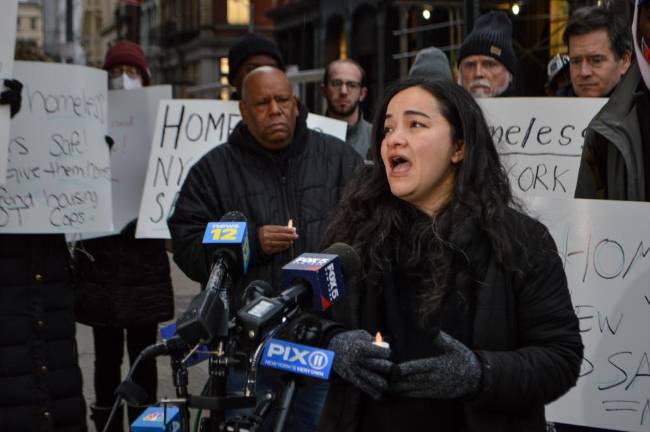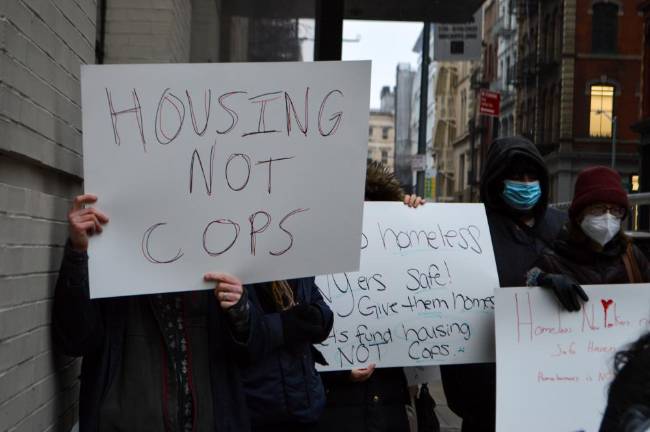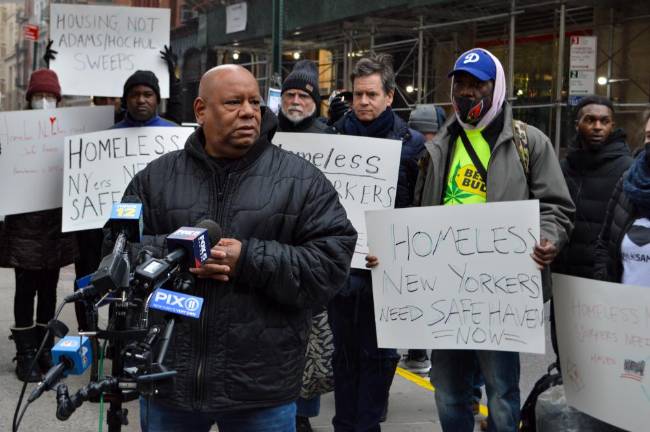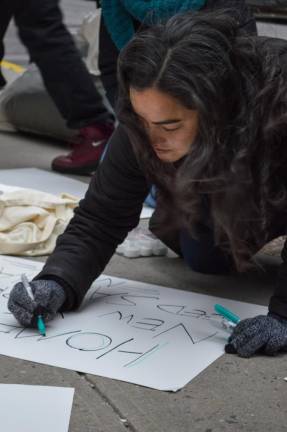Activists Back ‘Safe Havens’ For Homeless After Shootings
Gunman arrested in connection with attacks on homeless men in Manhattan and D.C.




In a flurry of snow and freezing temperatures last weekend, activists huddled together in Downtown Manhattan near the site where just a little over 24 hours earlier, a homeless New Yorker had been shot and killed, likely by a now-apprehended gunman suspected of carrying out at least five attacks — two of which have been fatal — in New York City and Washington, D.C.
The message at Sunday night’s vigil was clear: Homeless people in New York need private housing — not just access to congregate shelters, which some condemn as dangerous and undesirable — to keep them out of harm’s way. “We’re losing people out here,” said Shams “Da Homeless Hero” DaBaron, who formerly experienced homelessness himself.
As demonstrators raised signs and held battery-powered candles during the March 13 gathering at the intersection of Howard Street and Lafayette Street, another homeless man was found dead in Tribeca, not in connection with the other crimes. The number of deaths of homeless people has skyrocketed in recent years, according to city data, which shows that murders of homeless people have increased over 200 percent since 2018.
The most recent spurt of violence comes on the heels of Mayor Eric Adams’ new effort to remove homeless people from the subway, following a rise in aggression underground. Adams, during a press conference in D.C. on Monday, rejected the notion that his initiative in any way correlated with the recent and deadly attacks against homeless New Yorkers. Activists, meanwhile, have long advocated for a different approach to aiding the city’s homeless population, championing funding for what are known as “Safe Havens,” a form of low-threshold, private housing overseen by the New York City Department of Homeless Services (DHS). Adams’ plan calls for an additional 140 such beds.
At Risk
Attacks against subway riders, some at the hands of homeless people suffering from mental illness, have made headlines in recent weeks; Michelle Go was pushed in front of and killed by an oncoming train in mid-January, and a slew of non-fatal incidents of violence, most not perpetrated by homeless assailants, followed in February. “We knew, when we heard escalating rhetoric against homeless New Yorkers, that this type of violence was going to happen,” said Corinne Low, co-founder and executive director of Open Hearts Initiative, a local volunteer organization.
Speakers at the Sunday evening vigil insisted that by and large, it’s homeless people who are at high risk themselves. “People who are without a home are actually, for the most part, vulnerable,” said State Senator Brian Kavanagh, “for the most part, just trying to get by in a very difficult city to get by” in.
On Saturday, March 12, the NYPD reported two separate shootings, the first of a man sleeping outside on King Street between Varick Street and Avenue of the Americas, resulting in EMS transporting the victim to Bellevue Hospital. Later that evening, a second man was found in a sleeping bag outside 148 Lafayette Street with fatal gunshot wounds to the head and neck. The incidents in New York were linked with those in D.C. via social media, when the Metropolitan Police Department’s Homicide Unit head spotted an image of the New York City suspect that had been released to the public.
By Tuesday morning, an arrest was made in D.C. of suspect Gerald Brevard III, who is reported to have suffered from mental illness and been previously charged with other crimes. “This was a cold-blooded attack,” Adams said on Monday.
The events sparked outrage from local elected officials. “It was a horrendous attack,” City Council Member Christopher Marte, whose District 1 encompasses much of Downtown Manhattan, told Our Town Downtown. “These people were sleeping.”
Finding A Home
New York is a “right to shelter” city; anyone experiencing homelessness must be provided accommodation should they choose to seek it out. “There’s nothing dignified” about living in a subway station, Adams told press. But his recently-proposed preliminary budget for the city includes a drop in DHS funding from roughly $2.8 billion to just over $2.15 billion. Of almost 500 people removed from subways in the first week of Adams’ initiative to clear trains and stations this month, only 22 agreed to receive shelter services.
Marte told Our Town Downtown that his office is conducting outreach efforts with a multifaceted, individualized approach — not just with the goal of getting people into shelters, but with the intent of connecting homeless New Yorkers with services “where they’re at.” There should be a sense of urgency, he added, to improve shelters and other forms of housing for those in need.
DaBaron raised a central question at the vigil when he asked, in regards to the two homeless men targeted over the weekend, “why were these people — and others — sleeping in the streets last night when the weather was below 30 degrees?”
Activists say the reason is unsafe and “dehumanizing” conditions in congregate shelters, which they argue can be less hospitable than the city’s streets and subways. They’re pushing for attention and funds to be funneled toward housing of a more permanent, individualized and holistic nature. “The best way to end violence against homeless people living on our streets is to provide them with safe and secure housing that offers them privacy, dignity and the health care, behavioral health services and case management that supports them in living their lives whole,” said Charles King, CEO of Housing Works, in a statement following the event.
Eyes grew teary as speakers repeatedly emphasized that those who had been targeted in the string of recent attacks — and all of those facing homelessness — are fellow New Yorkers. “They can be me,” Vocal-NY Organizing Director Jawanza Williams said, “they can be you.”
“We knew, when we heard escalating rhetoric against homeless New Yorkers, that this type of violence was going to happen.” Corinne Low, co-founder and executive director of Open Hearts Initiative